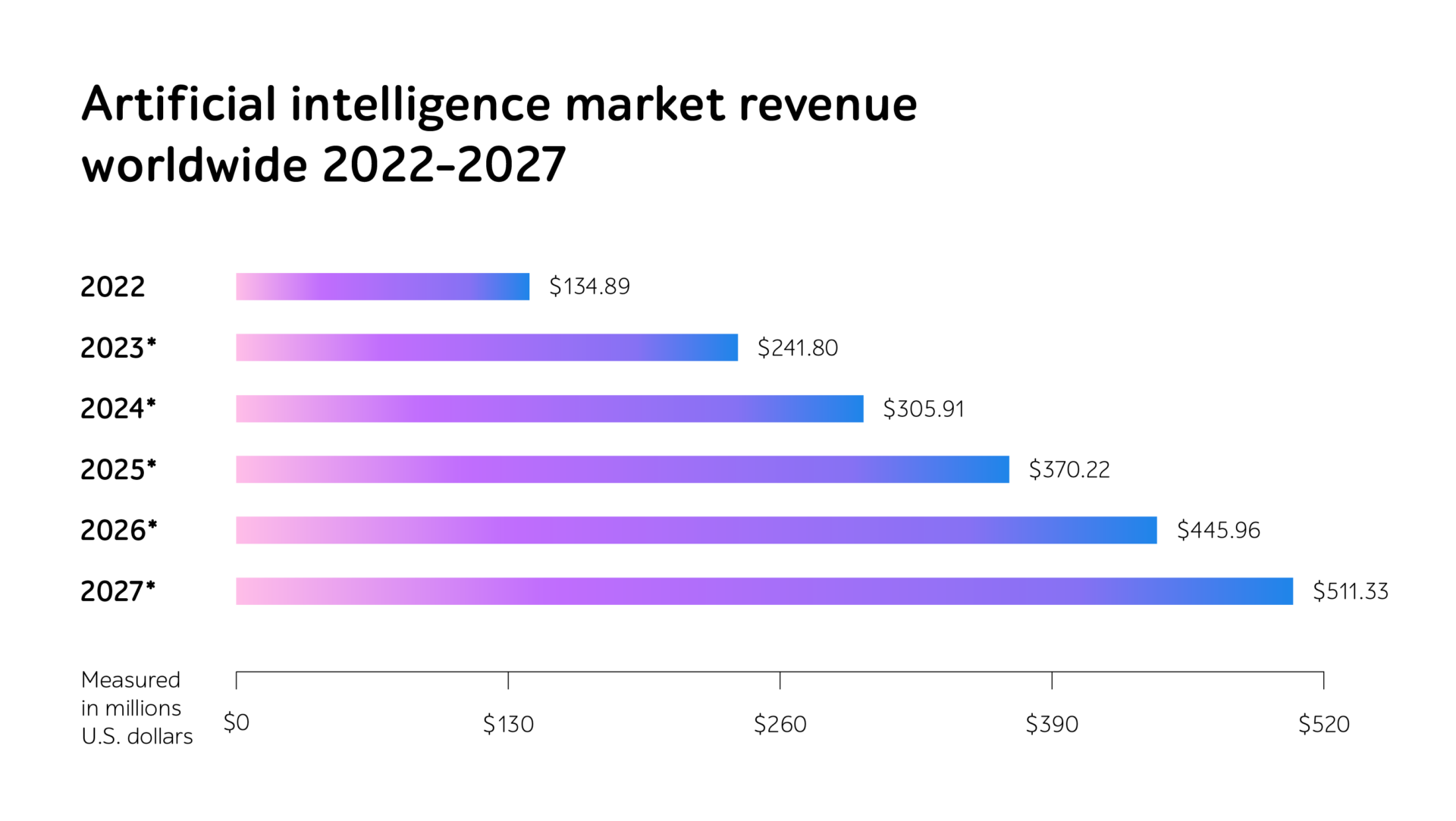
6 activities to supercharge test automation with AI and ML
Implementing AI- and ML-based technologies provides fast decision-making and better optimization of problem-solving processes. According to Forbes Advisor, 64% of businesses anticipate AI will increase productivity and 60% think it will drive sales growth.
Within a new era of automation, AI and ML are seen as inevitable parts of software development that strengthen competitive advantage and assist in achieving more accurate results. The same happens with the QA function, including test automation.
In this post, let’s look at the test automation activities where AI and ML may be helpful and learn the advantages they bring to the table.
AI- and ML-empowered test automation. Which side are you on?
According to Statista, the AI market totaled $134.89 billion in 2022 while in 2027 it will reach $511.33 billion.

Source: Statista
It’s not that surprising, considering AI and ML aid to improve the quality of IT products, speed up the testing process, and…
Ensure faster time to market
While traditional test automation helps deliver software faster, introducing AI and ML to the process allows launching IT solutions even more rapidly within ever-evolving software development methods and constantly increasing end-user demands.
Reduce the number of discrepancies
By implementing smart decision-making and automated control of processes, companies decrease human intervention. This frees up QA efforts allowing QA teams to focus on the core objectives.
Improve flexibility
Within continuously emerging changes in software development approaches, QA processes, and customers’ needs, AI and ML-enabled technologies are more adaptable than people, adjusting all the necessary components and workflows automatically in a matter of seconds.
Increase the overall test coverage
Automated test coverage detection allows writing much more scripts in an hour as well as running them and getting results — all with the optimized scope.
Reinforce codeless automation
Manually writing scripts is time- and labor-consuming, while AI and ML simplify traditional automated testing within the ability to perform codeless checks. Smart test automation tools assess QA risks, update test cases, detect issues, and prioritize tasks.
Enable better code maintenance
As software evolves, new features are added, therefore, existing code is modified, so QA experts have to regularly adapt test suites.
To reduce manual efforts on constant updates of the automation code, they leverage AI that assists in understanding the impact of code changes, identifying which tests are affected, and suggesting necessary adjustments to test scripts.
Amplify test data generation and management
AI allows businesses to create realistic and diverse test data sets, covering a wide range of scenarios, which is especially valuable for complex systems. This helps QA engineers perform comprehensive testing and identify data-related issues early in the SDLC.
AI, ML, are you there to help test automation?
According to the World Quality Report 2022-23, last year, companies benefited from implementing automated testing. 52.7% of respondents improved software quality, 52.1% — perceived better cost control, and 51.7% — accelerated software releases. Of course, we all want more. Here’s what you can do for that.
Activity #1. Introduce smart test scripts
While interacting with the software, AI collects data, makes screenshots, and tests the load. These steps undergo repetitions that help ML technologies learn the expected pattern and compare it to the behavior of the program. When it detects some deviations, the ML algorithms mark it as a potential error. After this, QA specialists manually intervene during the testing process to see if the identified bug is a real problem. The QA experts conduct final verifications to decide what to do next.
Activity #2. Optimize test automation with self-healing AI functions
Self-healing AI tools can easily adapt to changes in the app UI. By running tests, these instruments discover all the elements and occurring activities while recording them and assessing potential QA risks.
When AI- and ML-based algorithms detect some modifications, the tests change automatically. This helps remove threats before they occur while distinguishing whether the program’s behavior is normal or abnormal, triggering recovery activities when the software has deviations.
It’s important to mention that AI-based projects provide the whole scope of benefits only in the long-term perspective. The more errors appear for ML, then the more efficient and trusted further performance will be.
Activity #3. Conduct GUI test automation with ML
With ML, testing of the graphic user interface has entered the next level. Now, the old-school process of manually checking UI elements in accordance with mock-ups is automated within ML-powered algorithms.
Image-based testing is becoming the mainstream as ML-powered algorithms recognize different patterns and perform visual verification even on various devices and their configurations.
Given that 81% of consumers are ready to pay more for better UI, there is no room for errors.
Thus, ML-based technologies simplify automated GUI testing and help deliver reliable and user-friendly software.
Activity #4. Leverage AI for API testing
Due to the complexity and volume of API endpoints in modern software, API testing often poses challenges while being a time-consuming task.
With AI at the core, companies can simulate complex user interactions with APIs, identify patterns in API behavior, and predict potential issues based on historical data. They expedite QA processes, streamline the automation of API tests, and boost test case generation.
Activity #5. Optimize regression testing
As applications evolve, it becomes challenging to ensure that new code don’t introduce defects into existing functionality. Though test automation aids to speed up regression processes significantly, AI brings even more value to the table.
AI employs data-driven insights to analyze past test results, code changes, and defect histories to intelligently recommend which tests to run, examine high-impact areas, and uncover critical issues. This approach allows organizations to enhance the efficiency of regression testing, resulting in faster feedback and more stable software releases.
Activity #6. Adopt automated monitoring
Automation has already reduced human intervention and accelerated testing processes compared to those performed manually. AI- and ML-based technologies speed up workflows twice as fast.
Machines are powerless when performing tasks that require human monitoring and decision-making. To ensure software and hardware operate with no downtimes and pauses for controlling, checking, and analyzing, forward-looking companies introduce AI-and ML-enabled algorithms while optimizing routine actions and shortening the delivery time.
Closing remark
AI and ML can be used as part of the QA process and will never replace some manual activities or test automation-related checks. So, for some work, especially mentioned above, AI and ML might be introduced to simplify QA processes.
On the other hand, while introducing them, it’s important to calculate which efforts on QA will be saved, and which of them will become extra for other teams.
With total optimization of operational and business processes, AI- and ML-powered technologies assist in alleviating test automation workflows and minimizing human intervention. By introducing smart test scripts, ML-based monitoring, self-healing AI functions, image-based GUI test automation as well as leveraging AI for regression and API testing, companies are taking leading positions in the market.
Reach out to a1qa’s experts to get support on implementing test automation to enhance your software quality and release error-free and secure software in production.








